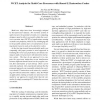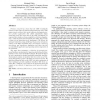23 search results - page 3 / 5 » Bounding Worst-Case Instruction Cache Performance |
RTSS
2006
IEEE
14 years 1 months ago
2006
IEEE
Caches have become invaluable for higher-end architectures to hide, in part, the increasing gap between processor speed and memory access times. While the effect of caches on timi...
RTAS
2008
IEEE
14 years 2 months ago
2008
IEEE
Multi-core chips have been increasingly adopted by microprocessor industry. For real-time systems to safely harness the potential of multi-core computing, designers must be able t...
CASES
2008
ACM
13 years 9 months ago
2008
ACM
Dynamic binary translators (DBT) have recently attracted much attention for embedded systems. The effective implementation of DBT in these systems is challenging due to tight cons...
ISCA
1995
IEEE
13 years 11 months ago
1995
IEEE
Previous research has shown that the SPEC benchmarks achieve low miss ratios in relatively small instruction caches. This paper presents evidence that current software-development...
PDPTA
2004
13 years 9 months ago
2004
We present the MBRAM model for static evaluation of the performance of memory-bound programs. The MBRAM model predicts the actual running time of a memory-bound program directly fr...


